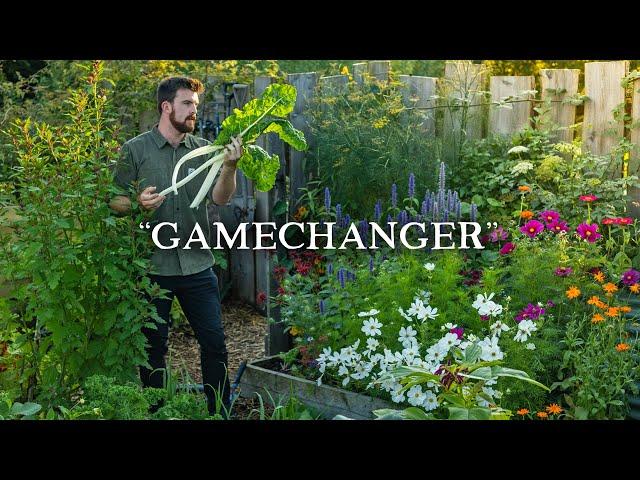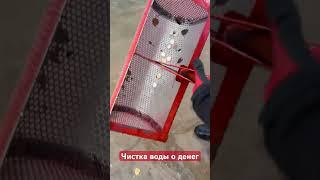
The Hidden Permaculture Principle (& How To Use It)
Комментарии:

Growing zinnias from seed in my garden is not only a delight for indoor displays and small arrangements but also attracts pollinators and provides shade for the crops underneath. However, my favorite aspect of growing zinnias is the boost they give to my self-esteem. Once I learned how to grow and cut them regularly to encourage continued blooming, I realized I had some real gardening skills, and I’ve been passionate about gardening ever since.
Ответить
Here everything works together in many ways....the plants and the trees for food and shelter and mulch and midicinal care....the chickes and ducks for eating the slugs and giving furtilizer and eggs....the birds in the trees eating bugs....like us people everything has many different functions. I love beeing in my garden and seeing everything working together! People shood take an example to nature and start working together too....
Ответить
Pumpkins (this game feels a little longer Boggle the game haha)
Driving me mad with how fast they grow>practicing patience
Practice pruning skills
Edible
Decorative
Many different varieties
Seed saving
Edible seeds
Edible leaves
Discover new recipes
Invent new recipes
Share recipes with others
Have a dinner party with the star of the evening of course being Pumpkin and Friends
Pumpkin lavacake 😋🤤
Cover crop
Mulch
Compost
Make better/faster compost by growing them in fresh manure
Pretty flowers
Edible flowers
Different flavours
Good for pollinators
Climbing for shade
Make a walkway underneath trellis with pumpkins
Halloween decorations
Probably fit to use as a dye
Eliminator of grass
Three Sisters
Always a surprise how many are hiding underneath the leaves
Abundance of crop to share with friends/neighbours
Hiding spot for the kitty
Safe place for other critters
Lasts long in the pantry to overcome the Hunger gap
I'll come back tomorrow and add to the list haha

We have Ivy plants growing over a huge 12 foot fence, built by my neighbor and planted by my neighbor. Initially I was annoyed by it's spreading growth habit -- it literally could take over the world but I've made my peace with it. Here is my "cup half full " approach to it. It provides a privacy barrier between neighboring properties; the bees love the flowers; the leaves are used as a medicinal herb; it provides mulch for the garden; it shades the periphery garden soil acting as a weed suppressant and I make lovely fall wreaths from it's leaves ,seed heads and flowers.
Ответить
Note: I'm not entering the competition, I started writing this comment before I got to the end and you told everyone to do this 😂
I am a broken record on mustard, my most favourite plant ever. The leaves, seeds, and flowers are edible. It can be used as fodder. It has a big tap root to help break up clay soil. It's drought and frost tolerant. It's a biofumigant. It's a fantastic trap crop for aphids and cabbage whites. Because it's a trap crop, it attracts beneficial and parasitoid insects. If plants are cut back but not removed, the woody stems provide overwintering habitat for beneficial insects. A ring of mustard seedlings or chop/drop leaves protects seeds/transplants from slugs and snails. It makes great chop and drop mulch or compost greens. It feeds the bees in winter when there's not many other flowers around. If you let it grow big enough, it will be sturdy enough for other plants to climb on. I'm probably still forgetting something. Hands down my favourite plant.
Another example of stacking functions in my garden is my rotating compost bin system. I put a compost bin down somewhere that I think the soil needs to be improved, and over the next few months I casually add materials to it. In summer I might plant things around the base of the compost bin, and then rather than watering those plants directly, I water the compost (usually with grey water - another stacking function). This speeds up the composting process inside the bin and creates a reservoir of moisture, nutrients, and life underneath, which the plants can tap into, which reduces the amount that I need to water. When I'm satisfied that the compost is done enough, I lift off the bin, spread the compost around, and find a new spot for the bin to start over. Because I'm using the compost right where I made it, it means that I'm not having to shovel compost into a wheelbarrow and move it from place to place, so it's an energy saving thing strategy also.
Accidental stacking function: last year in my tomato bed, a bunch of volunteer cosmos came up, and I let them grow. It turned out to be a fantastic stroke of laziness because when they grew to be six feet tall, their feathery foliage gave the tomatoes just enough dappled shade to stop them being scalded, but the cerise flowers hid the tomatoes from the birds. I didn't have to erect netting or shade, and I didn't lose a single tomato until right at the end of the season when things started to naturally thin out. I got kilos and kilos of fruit where the previous year (no cosmos, no net) I lost so many to birds. And of course, the flowers look gorgeous, attract pollinators, can be used for cut flowers.. and the plants are fast growing and can be used as chop and drop mulch or added to compost. And they self seed so easily that once you have them, you never have to buy them again.
Stacking functions in the garden makes me so happy. It is SO satisfying.

Love that you stacked pots to explain about stacking functions. :D
Ответить
And I just discovered another benefit of marigolds hydrolates ❤
Ответить
Peach Tree:
Shade for our soon to be son
Food source for our local wildlife
Soil conservation
Leaves for tea and tinctures

Sounds great Huw, but the secret is to harvest your crop, unless you can get into your garden everyday, the plants grow too fast for people who only have one day or a few hours a week. Have been vegetable gardening for over 40 years, my garden has only become trully productive etc, when I can go into it several times a day, which is now as I work from home.
Ответить
NASTURTIUMS: MY FAVOURITE FLOWER!
Edible stems, seeds, flowers and leaves - Vit C source,
Attracts pollinators,
Attracts aphids - companion plant,
Mulch,
Repels unwelcome insects that eat brassicas eg cabbage white,
Looks attractive - vibrant colours, leaf shape,
Low maintenance (Self seeds, drought tolerant),
Trailing and climbing functions,
Medicinal use - antiseptic/antibacterial,
Compost,
Shelter,
Ground cover

Many thanks Huw... you've got my old brain cells ticking
Ответить
Love your channel. Potato = Food, compost, mulch, breaks up hard soil, recycle store bought potatoes, carve into stamp, defog glasses or goggles.
Ответить
This is a great video to save & share. Saving to refer back on. Using & stacking elements of permaculture is what its all about😊
Ответить
Amaranth:
* As beautiful drops of colour in the garden.
* For cutflowers
* To dry
* To eat the leaves as lettuce
* To eat the seeds
* To grow for seeds for replanting
* For growing in pots for giving away as gifts
Thank you for this very inspiring video 🥰🙏🪻

Oh wonderful the moasure will be brilliant for helping me work out accurate contour lines for our swale systems :)
Ответить
I love our pigeon pea plants. They make wonderful wind breaks, shade for other plants, cut forage for our goats, the bees like the flowers, can eat the dried peas (Dal), great chop and drop mulch/nitrogen fixer, also makes great kindling/fire wood. Best stuff if you can grow it in your climate ❤
Ответить
World record!
before it even hit the ground 😂

Stacking a Mammoth Sunflower: feeds birds, squirrels, and the bees, seed saving and roasting, leaves for compost, leaves for shade to grow cool weather crops underneath, leaves as mulch/weedbarrier, stalk for climbing crops, multiple dried stalks can become next years poles for building afraid trellis, add stalks to the bottom of new raised beds for filler and nutrients as they breakdown, and my all time favorite way to use the stalk is to give it to my dog, Roxane. She will happily run around the yard with the giant stalk and run into everything, drop it and pick it back up. No need to even throw this stick. It’s hours of hilarious fun!
Ответить
I have an edible cosmos. Stumbled on it accidentally, but was excited for its multi purpose use.
Ответить
I grow lots of chillies. Functions being…
- eating tasty chilli varieties you cant buy
- creating ferments/sauces (my main hobby and keeps me occupied for months)
-good for polinators
- pollinators also = flying cat entertainment/occasional cat snacks
-decorate my sad conservatory
-creates compost once dead
-enables me to feel like im gardening even though im crap (because they grow really well in my conservatory and dont mind not being watered for ages)
-create a source of fun christmas and birthday presents (cos its easy to grow loads of them)
-create kitchen decorations once dried and sewn together
-keep reminding you of the importance of regularly washing your hands, long after covid has passed

Piracicaba broccoli:
Sprouts are edible
Leaves are edible
Immature flower heads are edible
Flowers are edible
Seed pods are edible
Stems used to flavor stews or stocks
Grows continuously through the season
Pollinators love it; bees hummingbirds
Home for predator bugs
Home for praying mantis’s
Once mature creates great shade to grow crops under; carrots beets etc
One of my most abundant producing crops
Beautiful flowers for visual enjoyment
Lots of bulk for compost
Highly recommended

This is such a simple thing but probably one so many of us haven’t thought about!! Thanks for bringing it to our attentions Huw!
Ответить
I use some old IKEA bathroom step stools for everything, rain water collection bucket of plant waste (Compost) and also a step stool
Ответить
Basil!
Smells lovely, edible, medicinal, flowering, attracts insects, and makes my tomatoes even more tastier.

Great video. I like the idea of stacking finding multiple uses and options for a crop for a closed system
My stack example would be
Calendula english marigolds
- Culinary Uses
- Medicinal Uses
- Garden Companion Plant
- Natural Dye
- Compost Enhancer
- Cosmetic Uses
- Pet Care
- Decorative and Cultural Uses
So many different ways of looking at a plants uses. It certainly opens up your imagination

I have a star Jasmine in the middle of a long border, which has posts with wires along it. The star Jasmine provides a pretty, evergreen centre backdrop for three seasons, flowering in the Summer. The flowers are loved by pollinators. The roots stabilise my sandy loam soil and the main stem hides the middle post nicely. The white flowers brighten the middle of the border in Summer evenings when the garden is in use later on. Wildlife likes hiding behind it, e.g. little beasties. It protects the fir hedge behind it from being Sun scorched in the Summer. I love the smell of the flowers! 😊
Ответить
Late summer/fall planted kale: baby kale in salads, sweating large leaves with other greens as a side dish, freezing large ribbon cut leaves for smoothies, early spring trap crop for aphids, cabbage loopers & cabbage worms, chop & drop into pathways IF leaves are pest free, leaving roots to decompose in soil to feed the next crop
Ответить
What an amazing video. Im new to growing basil but so far
Tastes amazing, pesto for days!
Improves flavour of my tomatoes
Good for pollinators
Smells amazing in the tunnel

Hi, would you mind telling me, on average, how far apart did are your contour lines for planting? We started creating a food forest late last year and I put my swales around 6 metres apart.
Ответить
I’m using Tagasaste to feed the bees, provide a wind break, then I’ll coppice it for firewood and mulch. All the while it’ll be fixing nitrogen in the soil.
Ответить
Okay, i'll choose one of your favourites: peas. Yummy food of course, creating a privacy screen on a fence separating gardens, a tipi to play in, creating shade for other plants, add to the beauty of the garden, biodiversity of planting, food for insects and pollinators, composting material, seed collection, making friends through seed sharing, shooting at annoying people through a pea shooter, creating a percussion instrument, using as weight to stop pastry rising in the oven, drying for food out of season, putting inside fabric pyramids to act as fabric weights when sewing, piercing and stringing to create jewellery, creating a dye. Goodness, that was more than I anticipated.
Ответить
I planted nastirtiums last year and now they've taken over my garden. They are so versatile! They're beautiful flowers. The bees love them. I love eating the flowers, and when it's too hot in Mt garden for salad, I use their leaves in salads, and even in gazpacho instead of pepper! They're ground cover, and also attract pests, keeping them away from my brassicas. They grow where nothing else wants to grow and cover my stone walls that would otherwise e covered with brambles. I made "capers" with their seeds, and their seeds are also birdfood I imagine. They fill bed corners, and plant themselves so I don't have to!🏵
Ответить
Nasturtiums, look nice, eat the flowers, eat the shoots, pickle the seed pods and as a medicine - you can make a tea from the leaves to help a mucusy cough!
Ответить
beetroot - Soup, pickle, leafs as spinach, smoothie, sweetner, juice, pickle juice to help with pre training drink, stalks dried for beetroot powder, leaf for salad
Ответить
I think field beans are a great example of stacking functions. They improve the soil, act as a cover crop over winter, can have beans harvested from them in spring and you get loads of green material to add to the compost heap to make compost for growing more vegetables.
Ответить
Hazel Trees 🌰
- of course hazel nuts for you, the squirrels and dormice 🐿️
- They can be coppiced to produce an endless supply of material for fences, plant supports and baskets 🧺
- They provide shelter for nesting birds
- And food for insects such as moths
- They can be used for hedging to create a wind break
- Or they can create light dappled shade due to their open canopy

Beautiful visual examples. Your awesome
Ответить
Hello How, thanks for all your hard work I really enjoy watching your videos and appreciate all that you do! So for my plant, I chose sunflowers. The primary function: 1. it's my favorite flower, it makes me happy (for aesthetics).
Continued Fucntions:
2. Important for pollinators
3. Food for bird's with their seeds
4. Also food for me, if there's any left from the birds ☺️
5. They are tall so I'm using them as a fence border in my backyard
6. Shade support for shade craps like lettuce varieties that I'm planting
7. Some will be used as a trellis for my peas, which in turn feeds the sunflowers by being nitrogen fixers.
8. I also save the stocks to make flutes and rain sticks I'm going to try this year.
9. I keep all my favorite flowers that I planted and dry them and then use them for various things like arts and crafts or put them in shadow boxes.
I know there's more but those are the main ones that I came up with! Hopefully I win the tickets 😀 thanks again

My first time growing Kalettes, it's the best looking plant in my allotment, it has lest pests, the cabbages next to them have been devastated, but the Kalettes hardly touched, I've used the leaves in Soup, they've stopped a lot of weeds growing as there so big and healthy, I'm waiting for the Kalettes to form as an extra crop and they will hopefully produce a crop over winter when not as much is growing.
Ответить
Stacking functions of beetroot:
Beet root to harvest (raw, boiled, roasted, pickled, fermented, relish!)
Baby leaves
Soil cover
Let flower and keep seeds
Compost/feed chickens old leaves
Thanks Hew for your very inspiring videos

Comfrey’s stacked functions:
• Nutrient Accumulator: Deep roots pull up nutrients like potassium and calcium, enriching the soil.
• Compost Booster: Use leaves as a fast-breaking compost activator.
• Natural Fertilizer: Leaves work great as mulch or liquid feed.
• Medicinal Uses: Known for healing properties, used for wounds and inflammation.
• Pest Deterrent: Rough leaves keep pests at bay.
• Animal Feed: Nutritious feed for chickens, rabbits, and livestock.
• Erosion Control: Roots stabilize soil on slopes.
• Improves Soil: Aerates and improves soil structure.
• Attracts Pollinators: Flowers bring in bees and beneficial insects.
• Living Barrier: Acts as a natural hedge or border.
• Aesthetic Value: Adds greenery and flowers to the garden.

For a chance to enter to win a ticket, we have a perennial chili plant just outside our door against a brick house. For us, it functions as many things, of course we use the ripe red chilies for homemade chili oil, or in our salads, etc. but we also use the perky white flowers frozen in ice to have a nice spicy lemonade in summer, it is our go to for kitchen water from steaming veggies or cooking beans to ensure those nutrients don't go to waste (especially when it is dark and we don't want to go all the way to the garden), it serves as a lovely spot to have tea through winter with something still lovely and green to admire, we also use it to gather seeds, and grow seedlings and share with friends and have even sold a few, We also use one of its lower thicker branches as a handy hook for the hose nozzle, and I am sure I could come up with many other ideas but people may start to think I have an unhealthy obsession with my favourite chili plant. lol
Ответить
Sunchokes/Jerusalem Artichokes
* For screen off the neighbours
* Flowers for insects to enjoy
* To trellis my pea shoots, cucumbers and beans
* To break up into compost
* Use leaves to make liquid fertilizer
* use the stem (after it's dried) and combed for spinning cloth and kindle fire and or use as support sticks for other plants and cover the pergola as a tied Sunchocke matt for protection against some rain
* leaves as feed for the wormery
* Cut flowers
* To cast shade
* Of course harvest and cook and eat the Sunchokes

Pumpkin: for eating; for decoration; use for seed the following year; a stool to sit on; foot rest (and for a chair if you have 2); to stand on to reach blackberries on the top of the bush; hollow it put to make a bowl; use it to store your car keys; put it on the compost
Ответить
Comfrey - stacking uses - feeds bees, purple flowers look good, leaf from and texture interest in plot, to create plant feed, to create healing skin balm. 😀
Ответить
My favourite stacking plant is cucumbers. I use cucumbers to shade the tomatoes that are in the direction where the sun is the strongest for dapple shade, I grow basil and other herbs underneath it. I use the leaves for compost and the bumble bees love my russian gurkens so more pollinators come for my zuchinnis and other plants.
Ответить
Is there any free trustworthy tutials for that technology he using it looks like it could be useful, cheers in advance
Ответить
Great Video!. Thanks. Which program or software are you using to design after measuring?
Ответить
Blackberries have been amazing this year. They have tons of functions:
Eating the raw berries, cooking the berries (into jams, jellies, shortbread and more), forage fpr the bees and other insects, a pretty wall of flowers, they create a natural barrier and structure, the stems can be used as mini slug walls, they make great protected homes for the frogs and toads, teas can be made from the leaves, the leaves make tasty snacks for the sheep, berries feed the birds, any excess growth goes for compost. And probably plenty more!


























